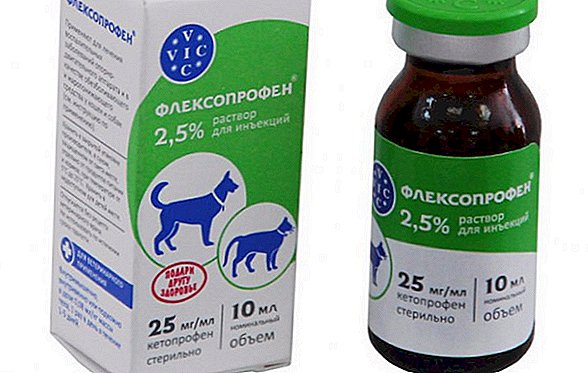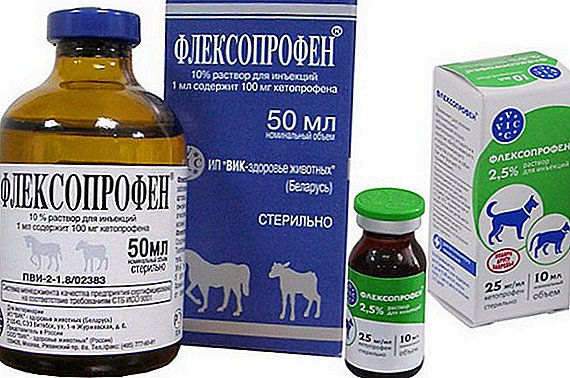 Nobody is insured against illnesses, including our smaller brothers.
Nobody is insured against illnesses, including our smaller brothers.
The duty of every owner is to provide his pet with proper treatment and care.
In this article, we consider the drug "Flexoprofen", its instructions for use in veterinary medicine.
Composition, release form, packaging
The main active ingredient - ketoprofen, additionally contains L-arginine, benzene alcohol, citric acid and water for injection.  Colorless 2.5% solution is produced in dark glass containers with volumes of 5, 10, 20, 30, 50, 100, 200 and 250 ml, in a carton package there is an insert with instructions.
Colorless 2.5% solution is produced in dark glass containers with volumes of 5, 10, 20, 30, 50, 100, 200 and 250 ml, in a carton package there is an insert with instructions.
Pharmacological properties
"Flexoprofen" has anti-inflammatory, analgesic and antipyretic effects for animals.
For anti-inflammatory also include "Deksafort", "Solikoks."In chronic inflammations it weakens pain in the joints when moving, relieves swelling, supports the structure of cell membranes, preventing them from breaking, slows down the production of prostaglandins, thereby preventing the development of the inflammatory process.
After intramuscular injection, the action occurs within half an hour, it is eliminated from the body naturally.
For whom is suitable
"Flexoprofen", according to the instructions, suitable for cats, dogs, sheep, goats, pigs, cattle and calves.
Did you know? The first horse was even smaller than today's ponies: height at the withers is about 35 cm, and weight is about 5 kg. This horse lived more than sixty million years ago. Scientists gave her the name Eogippus. It is noteworthy that instead of hoofs she had fingers: on the front legs four, and three on the rear.The drug is often used for injuries of sports horses.

Indications for use
The main indication is the treatment of such diseases of the musculoskeletal system in animals as:
- arthritis;
- arthrosis;
- osteoarthritis;
- sprains;
- joint dysplasia;
- swelling;
- intervertebral hernia;
- synovitis;
- tendosynovitis;
- hyperthermia.
Dosage and administration
The dosage for each individual must be determined by the veterinarian, depending on the weight of the animal and its physique, the injection site and dose vary.
Cattle
Adults and calves: in a vein or muscle, 3 mg / kg once a day, about five days. 
Pigs
Pigs are injected into a muscle at the rate of 3 mg / kg of body weight, one dose per day, and duration from five days to a week.
Learn all about the breeding of such breeds of pigs as landrace, karmala pigs, Pietrain, Hungarian downy mangalitsa, Vietnamese, Duroc, Mirgorod, red-belt.
Sport horses
Horses are administered intravenously 2.2 mg / kg of body weight, a single dose, a course of one to five days.
Dogs and cats
"Flexoprofen" for cats and dogs dosage is 2 mg / kg, once a day, a course of one to five days. Enter the drug into a vein or muscle.
Did you know? In the US, there is a church whose dogs are members. So unusually thanked his Labradors for helping him overcome a serious illness, the artist Stefan Haneke, who built the church.
Precautions and special instructions
It is not recommended to skip the medication, you will have to renew the scheme again. It is not necessary to allow joint reception with other anti-inflammatory agents, with diuretic and blood thinning, steroid hormonal agents. You can not mix in the same syringe with other drugs.  During contact with the drug, you should not drink or eat food; after contact, wash hands thoroughly; in case of contact with skin or eyes, rinse with clean water.
During contact with the drug, you should not drink or eat food; after contact, wash hands thoroughly; in case of contact with skin or eyes, rinse with clean water.
Important! If, as a result of contact with the skin, an allergic reaction has begun, you should seek medical help, having an insert for the preparation on your hands.
Slaughter of farm animals for meat is allowed five days after the last dose of the agent; milk can be consumed without restrictions.
Contraindications, overdose symptoms and side effects
Among the contraindications are the following diseases:
- gastrointestinal ulcer;
- renal and hepatic failure;
- pregnancy;
- hemorrhagic syndrome;
- von Willebrand disease (in dogs).
 Overdose "Fleksopropenom" in animals can cause loss of appetite, vomiting or diarrhea, in the recommended quantities of side effects have been identified.
Overdose "Fleksopropenom" in animals can cause loss of appetite, vomiting or diarrhea, in the recommended quantities of side effects have been identified.Important! In case of allergy to the components, stop taking and give the pet an antihistamine.
Shelf life and storage conditions
The medication is kept out of the reach of children and animals, away from food and feed. When stored on the drug should not get sunlight, the permissible temperature from 0 ° C to +25 ° C. In a closed container can be stored for up to three years.
"Fleksopropen" received high reviews from pet owners and owners of agricultural cattle. However, remember that the unauthorized appointment of a medical product is unacceptable, you can cause an even greater harm to the sick animal.












